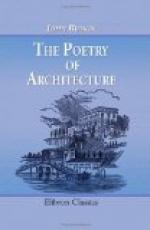82. It now only remains for us to conclude the subject of the cottage, by a few general remarks on the just application of modern buildings to adorn or vivify natural scenery.
There are, we think, only three cases in which the cottage is considered as an element of architectural, or any other kind of beauty, since it is ordinarily raised by the peasant where he likes, and how he likes; and, therefore, as we have seen, frequently in good taste.
83. I. When a nobleman, or man of fortune, amuses himself with superintending the erection of the domiciles of his domestics. II. When ornamental summer-houses, or mimicries of wigwams, are to be erected as ornamental adjuncts to a prospect which the owner has done all he can to spoil, that it may be worthy of the honor of having him to look at it. III. When the landlord exercises a certain degree of influence over the cottages of his tenants, or the improvements of the neighboring village, so as to induce such a tone of feeling in the new erections as he may think suitable to the situation.
84. In the first of these cases, there is little to be said; for the habitation of the domestic is generally a dependent feature of his master’s, and, therefore, to be considered as a part of it. Porters’ lodges are also dependent upon, and to be regulated by, the style of the architecture to which they are attached; and they are generally well managed in England, properly united with the gate, and adding to the effect of the entrance.
In the second case, as the act is in itself a barbarism, it would be useless to consider what would be the best mode of perpetrating it.
In the third case, we think it will be useful to apply a few general principles, deduced from positions formerly advanced.
85. All buildings are, of course, to be considered in connection with the country in which they are to be raised. Now, all landscape must possess one out of four distinct characters.
It must be either woody, the green country; cultivated, the blue country; wild, the gray country; or hilly, the brown country.
I. The Woody, or green, Country. By this is to be understood the mixture of park, pasture, and variegated forest, which is only to be seen in temperate climates, and in those parts of a kingdom which have not often changed proprietors, but have remained in unproductive beauty (or at least, furnishing timber only), the garden of the wealthier population. It is to be seen in no other country, perhaps, so well as in England. In other districts, we find extensive masses of black forest, but not the mixture of sunny glade, and various foliage, and dewy sward, which we meet with in the richer park districts of England. This kind of country is always surgy, oceanic, and massy, in its outline: it never affords blue distances, unless seen from a height; and, even then, the nearer groups are large, and draw away the attention from the background. The under soil is kept cool by the shade, and its vegetation rich; so that the prevailing color, except for a few days at the fall of the leaf, is a fresh green. A good example of this kind of country is the view from Richmond Hill.




